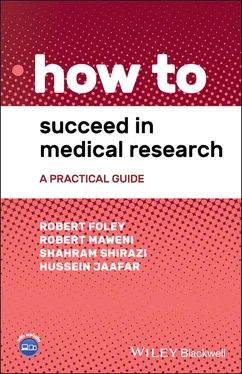1 Cover
2 Title Page How to Succeed in Medical Research A Practical Guide Robert Foley, MB BCh BAO, MSc, MCh, GradCert (Statistics), MRCS Specialist Registrar in Radiology Health Education England Severn Bristol, UK Robert Maweni, MB BCh BAO, MCh, MRCS (ENT) Specialist Registrar in Otorhinolaryngology Health Education England Thames Valley Oxford, UK Shahram Shirazi, MB BCh BAO, BSc, MRCS Specialist Registrar in General Surgery Health Education England London & South East London, UK Hussein Jaafar, BSc (Biomed), MSc (Neuroscience), PhD (Candidate) Life Science Consultant Life Science Dynamics London, UK
3 Copyright Page
4 Foreword
5 Preface
6 About the Companion Website
7 Chapter 1: How to get involved in research1.1 Why do research? 1.2 What can I become involved in? 1.3 Different types of research 1.4 Clinical vs laboratory 1.5 Getting ideas for research References
8 Chapter 2: Conducting a study2.1 How to find a research project 2.2 How to approach a mentor 2.3 Planning your study 2.4 Data collection
9 Chapter 3: Literature review and critical appraisal 3.1 Literature review 3.2 Search terms 3.3 Where to search 3.4 How to search 3.5 Critical appraisal
10 Chapter 4: Ethics and the ethical application4.1 What is medical ethics and why is it important? 4.2 Main ethical considerations in medical research 4.3 Practical ethical applications 4.4 Dealing with conflicts in ethics 4.5 Ethical applications
11 Chapter 5: Analysing your data 5.1 What I need to know and how to find it 5.2 Variables 5.3 Analysis of categorical and continuous variables in two groups 5.4 Sensitivity and specificity 5.5 Positive predictive value and negative predictive value 5.6 Receiver operating characteristic curves 5.7 Logistic regression analysis 5.8 Other types of analysis 5.9 How to present your results 5.10 Conclusion References
12 Chapter 6: Conferences and presentations 6.1 Types of conferences 6.2 Prices and prizes 6.3 Abstract submission 6.4 Title 6.5 Introduction 6.6 Methods 6.7 Results 6.8 Conclusion 6.9 Poster presentation 6.10 Podium presentation
13 Chapter 7: Writing a paper 7.1 Title 7.2 Abstract 7.3 Introduction 7.4 Methods 7.5 Results 7.6 Discussion 7.7 Conclusion 7.8 References 7.9 Sending to seniors for review Reference
14 Chapter 8: How to get published8.1 Which journal? 8.2 Authorship 8.3 Getting your paper ready for the journal 8.4 Dealing with reviewer comments 8.5 Dealing with rejection References
15 Chapter 9: Writing a case report 9.1 How to begin 9.2 Preparing to write the case report 9.3 Writing the case report References
16 Chapter 10: Basic laboratory research10.1 Introduction to laboratory research and translational research 10.2 Basic research versus clinical research 10.3 Laboratory hierarchy 10.4 Day to day of working in the lab 10.5 How to choose your lab
17 Chapter 11: Expanding your horizons in research 11.1 Research elective 11.2 Intercalated research degree 11.3 Postgraduate diplomas/certificates 11.4 Postgraduate degree
18 Chapter 12: Teaching12.1 How to get involved in teaching 12.2 Teaching as an undergraduate student 12.3 Teaching as a postgraduate student 12.4 Teaching at work 12.5 Planning a lesson 12.6 Getting the most out of your teaching 12.7 Running a teaching course 12.8 How to set up a novel teaching course 12.9 How to run an established course
19 Chapter 13: Conducting an audit13.1 What is clinical audit? 13.2 Conducting an audit
20 Chapter 14: Portfolio/CV14.1 Keeping a portfolio 14.2 Curriculum vitae (CV)
21 Chapter 15: Maintaining a good balance 15.1 Stress and burnout 15.2 Improving your mindset to promote resilience 15.3 Other methods for resilience 15.4 Practical tips References
22 Index
23 End User License Agreement
1 Chapter 2 Table 2.1 Hypothesis testing.
2 Chapter 5Table 5.1 Patient characteristics.Table 5.2 Patient characteristics.Table 5.3 2 × 2 table: test outcomes.Table 5.4 2 × 2 table: numeric test outcomes.Table 5.5 Logistic regression results.Table 5.6 Interpretation of the correlation coefficient (r).Table 5.7 Displaying data.
1 Chapter 1 Figure 1.1 The hierarchy of evidence.
2 Chapter 5Figure 5.1 (a) Normal distribution. (b) Skewed distribution.Figure 5.2 Flowchart describing the appropriate statistical test to use for ...Figure 5.3 Receiver operating characteristic curves.Figure 5.4 Radar chart.
3 Chapter 14Figure 14.1 An example reflection.Figure 14.2 An example of CV publication presentation.
1 Cover Page
2 How to Succeed in Medical Research
3 How to Succeed in Medical Research
4 Foreword
5 Preface
6 About the Companion Website
7 Table of Contents
8 Begin Reading
9 Index
10 WILEY END USER LICENSE AGREEMENT
1 iii
2 iv
3 ix
4 x
5 xi
6 xii
7 xiii
8 1
9 2
10 3
11 4
12 5
13 6
14 7
15 8
16 9
17 10
18 11
19 12
20 13
21 14
22 15
23 16
24 17
25 18
26 19
27 20
28 21
29 22
30 23
31 24
32 25
33 26
34 27
35 28
36 29
37 30
38 31
39 32
40 33
41 35
42 36
43 37
44 38
45 39
46 40
47 41
48 42
49 43
50 44
51 45
52 46
53 47
54 48
55 49
56 50
57 51
58 52
59 53
60 54
61 55
62 56
63 57
64 58
65 59
66 60
67 61
68 62
69 63
70 64
71 65
72 66
73 67
74 68
75 69
76 70
77 71
78 72
79 73
80 74
81 75
82 76
83 77
84 78
85 79
86 80
87 81
88 82
89 83
90 84
91 85
92 86
93 87
94 88
95 89
96 90
97 91
98 92
99 93
100 94
101 95
102 96
103 97
104 98
105 99
106 100
107 101
108 102
109 103
110 104
111 105
112 106
113 107
114 108
115 109
116 110
117 111
118 112
119 113
120 114
121 115
122 116
123 117
124 118
125 119
126 120
127 121
128 122
129 123
130 124
131 125
132 126
133 127
134 128
135 129
136 130
137 131
138 132
139 133
140 134
141 135
142 136
143 137
144 138
145 139
146 140
147 141
148 142
149 143
150 144
151 145
152 147
153 148
154 149
155 150
156 151
157 152
158 153
159 154
How to Succeed in Medical Research
A Practical Guide
Robert Foley, MB BCh BAO, MSc, MCh, GradCert (Statistics), MRCS
Specialist Registrar in Radiology
Health Education England Severn
Bristol, UK
Robert Maweni, MB BCh BAO, MCh, MRCS (ENT)
Specialist Registrar in Otorhinolaryngology
Health Education England Thames Valley
Oxford, UK
Shahram Shirazi, MB BCh BAO, BSc, MRCS
Specialist Registrar in General Surgery
Health Education England London & South East
London, UK
Hussein Jaafar, BSc (Biomed), MSc (Neuroscience), PhD (Candidate)
Life Science Consultant
Life Science Dynamics
London, UK

Читать дальше








![Коринн МакКей - How to Succeed as a Freelance Translator [calibre 3.46.0]](/books/402693/korinn-makkej-how-to-succeed-as-a-freelance-transl-thumb.webp)




